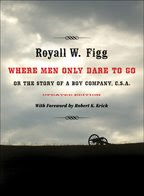[Confederate Struggle For Command: General James Longstreet and the First Corps in the West
by Alexander Mendoza (
Texas A&M University Press, 2008).
Cloth1, photos, illustrations, maps, notes, appendix, bibliography, index. Pages main/total: 215/304. ISBN: 978-1-60344-052-3 $32.95]
During the Civil War, both sides were plagued with command frictions, but the western Confederate armies highlighted a special brand of toxic bickering that had an enormous impact on military operations. The fact that it pervaded the high commands of the western and trans-Mississippi armies, but had comparatively little negative impact in Lee's army, certainly promotes the idea that success, if not actually breeding harmony, certainly helps to mute dissent. The degree to which command in-fighting could destroy an army's effectiveness is exemplified by the Army of Tennessee during the 1863 Chickamauga-Chattanooga campaigns. It is directly into this chaotic situation that James Longstreet and his First Corps was thrust in September 1863.
In the introduction to his book
Confederate Struggle For Command: General James Longstreet and the First Corps in the West, author Alexander Mendoza broadly characterizes his study as 'pro-Longstreet', but he is, in fact, deeply critical of the general's conduct during his six months in the west. It would probably be more accurate to say that Mendoza is most interested in providing a critical yet fair assessment of Longstreet, something he believes is missing from the literature (especially from the only previous book wholly dedicated to this period).
Longstreet made several errors in judgement right off the bat, including aligning with President Davis's political enemies and holding a preconceived negative view of General Bragg. On the positive side, Mendoza justifiably praises Longstreet's tactical planning at Chickamauga, especially in light of an almost complete lack of prior knowledge of the ground or dispositions of friend and foe. The author is critical of Longstreet's insistence on placing personal favorite Micah Jenkins in command of Hood's former division, an unpopular move after Chickamauga that created dissension within the officer ranks of the division. It doomed cooperation between Jenkins and Evander Law, an unfortunate by-product that, along with Longstreet's poor judgment, contributed to the loss of the western approaches to Chattanooga during the siege and carried over into the Knoxville campaign. After Lenoir and Campbell's Station, and the unsuccessful assault on Knoxville's Fort Sanders, it was becoming clear that First Corps command relationships were taking on the worst characteristics of the Army of Tennessee. Jerome Robertson and Lafayette McLaws were added to list of officers with command grievances against Longstreet.
According to Mendoza, Longstreet regained his confidence after the retreat from Knoxville toward the Tennessee-Virginia border area between the Holston and French Broad Rivers. Unfortunately, the lack of cooperation between subordinates helped upset a decent plan at Bean's Station, further exposing the weaknesses of Longstreet's command. It would take wholesale command reshuffling and a return to Lee's army in the spring of 1864 to return the First Corps to an effective fighting unit.
Mendoza writes very well, and at around 200 pages, his finely focused study employs an effective economy. It's also evident that he's gone back to the original source materials to construct his arguments; this is not a synthetic work. The cartography, on the other hand, is a source of disappointment in an otherwise high quality study. While the broad geographic overviews are not without use, the maps fail to seriously address unit movements and positions. The study's overall effectiveness is not greatly harmed, but a good opportunity to provide readers with a visual rendering and clearer understanding of the First Corps battlefield failures is missed.
With this fine study, Mendoza successfully places the personal and military strengths and weaknesses of General Longstreet within the larger contexts of the disastrously dysfunctional command situation of the Army of the Tennessee and the complete inability of the Davis Administration to ameliorate the problem(s).
Confederate Struggle for Command is worthy of recommendation on several fronts, from specific reader interests in Longstreet or the 1863-64 East Tennessee campaigns to broader studies of Confederate political and military command culture and failures. Professor Mendoza is a fresh face in the crowd of western theater Civil War scholars, and I look forward to reading his future contributions
2. Highly recommended.
Comments:
1 - As always, I like to express my appreciation for publishers that use full cloth boards for their hardcovers.
2 - “‘A Terrible Baptism By Fire’: Stuart’s Defense in The Battle of Shiloh, April 6, 1862,” in Steven E. Woodworth, ed., The Shiloh Campaign (Southern Illinois U. Press), forthcoming.
“‘The Harmony and Subordination Essential for Success’: Generals James Longstreet and Braxton Bragg in the Western Theater,” in Lawrence Lee Hewitt and Art Bergeron, eds., Confederate Generals in the Western Theater (University of Tennessee Press), forthcoming.
“Causes Lost, But Not Forgotten: George Washington Littlefield, Jefferson Davis, and the Confederate Statues at The University of Texas at Austin,” in Charles Grear, ed., The Fate of Texas: The Civil War and the Lone Star State (University of Arkansas Press, 2008).







